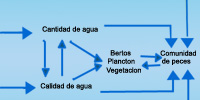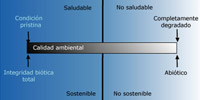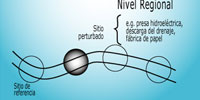|

Fig.1

Fig.2

Fig.3
|
|
|
Bibliografía
Aguilar
Ibarra, A. (2005) “Ecological indicators and society’s
values: monitoring, research and management of water quality
in rivers”. En: Burk, A.R. (ed.) Progress in aquatic
ecosystem research, NewYork: Nova Science Publishers,
pp. 37-60.
Aguilar
Ibarra, A., Dauba, F., Lim, P. (2005) “Influence
of non-point source pollution on riverine fish assemblages
in south west France”. Ecotoxicology, 14 (5): 1-16.
Allan,
J.D., Erickson, D.L., Fay, J. (1997) “The influence
of catchment land use on stream integrity across multiple
spatial scales”. Freshwater Biology, 37: 149-161.
Angermeier,
P.L., Schlosser, I.J. (1995) “Conserving aquatic
biodiversity: beyond species and populations”. American
Fisheries Society Symposium, 17: 402-414.
Angermeier,
P.L., Smogor, R.A. (1995) “Estimating number of
species and relative abundances in stream-fish communities:
effects of sampling effort and discontinuous spatial distributions”.
Canadian Journal of Fisheries and Aquatic Sciences, 52:
936-949.
Arlinghaus,
R., Mehner, T., Cowx, I.G. (2002) “Reconciling traditional
inland fisheries management and sustainability in industrialized
countries, with emphasis on Europe”. Fish and Fisheries,
3: 61-316.
Barbour,
M.T., Stribling, J.B., Karr, J.R. (1995). “Multimetric
approach for establishing biocriteria and measuring biological
condition”. En: Davis, W.S., Simon, T.P. (eds.)
Biological assessment and criteria: tools for water resource
planning and decision-making. Boca Raton: Lewis Publishers,
pp. 63-77.
Bohn,
B.A., Kershner, J. L. (2002) “Establishing aquatic
restoration priorities using a watershed approach”.
Journal of Environmental Management, 64: 355–363.
Boulton,
A.J. (1999) “An overview of river health assessment:
philosophies, practice, problems and prognosis”.
Freshwater Biology, 41: 469-479.
Caughlan,
L., Oakley, K.L. (2001) “Cost considerations for
long-term ecological monitoring”. Ecological Indicators,
1: 123–134.
Chessman,
B.C. (1999) “Predicting the macroinvertebrate faunas
of rivers by multiple regression of biological and environmental
differences”. Freshwater Biology, 41: 747-757.
Cooper,
S., Diehl, S. Kratz, K., Sarnelle, O. (1998) “Implications
of scale for patterns and processes in stream ecology”.
Australian Journal of Ecology, 23: 27-40.
Cowx,
I.G., Collares-Pereira, M.J. (2002) “Freshwater
fish conservation: options for the future”. En:
Collares-Pereira, M.J., Cowx, I.G., Coehlo, M.M. (eds)
Conservation of freshwater fishes: options for the future.
Fishing News Books, Blackwell Science, Oxford, pp. 443-452.
Dale,
V.H., Beyeler, S.C. (2001) “Challenges in the development
and use of ecological indicators”. Ecological Indicators,
1: 3–10.
Davis,
W.S. (1995) “Biological assessment and criteria:
building on the past”. En: Davis, W.S., Simon, T.P.
(eds.) Biological assessment and criteria: tools for water
resource planning and decision-making. Boca Raton: Lewis
Publishers, pp. 15-29.
Dolédec,
S., Statzner, B., Bournard, M. (1999) “Species traits
for future biomonitoring across ecoregions: patterns along
a human-impacted river”. Freshwater Biology, 42:
737-758.
Duncan,
J.R., Lockwood, J.L. (2001) “Extinction in a field
of bullets: a search for causes in the decline of the
world’s freshwater fishes”. Biological Conservation,
102: 97-105.
Fausch,
K.D., Lyons, J., Karr, J.R., Angermeier, P.L. (1990) “Fish
communities as indicators of environmental degradation”.
American Fisheries Society Symposium, 8: 123-144.
Finlayson,
C.M. (2003) “The challenge of integrating wetland
inventory, assessment and monitoring”. Aquatic Conservation:
Marine and Freshwater Ecosystems, 13: 281–286.
Gaston,
K.J., Spicer, J.I. (2000). Biodiversity: an introduction.
Oxford: Blackwell Science.
Harding,
J.S., Benfield, E.F., Bolstad, P.V., Helfman, G.S., Jones,
E.B.D. (1998) “Stream biodiversity: the ghost of
land use past”. Proceedings of the National Academy
of Sciences of the United States, 95: 14843-14847.
Hart,
B.T., Maher, B., Lawrence, I. (1999) “New generation
water quality guidelines for ecosystem protection”.
Freshwater Biology, 41: 347-359.
Havens,
K.E. (1999). “Correlation is not causation: a case
study of fisheries, trophic state and acidity in Florida
(USA) lakes”. Environmental Pollution, 106: 1-4.
Hughes,
R.M. (1995). “Defining acceptable biological status
by comparing with reference conditions”. En: Davis,
W.S., Simon, T.P. (eds.) Biological assessment and criteria:
tools for water resource planning and decision-making.
Boca Raton: Lewis Publishers, pp. 31-47.
Hughes,
R.M., Larsen, D.P., Omernik, J.M. (1986) “Regional
reference sites: a method for assessing stream potentials”.
Environmental Management, 10: 629-635.
Hughes,
R.M., Kaufman, P.R., Herlihy, A.T., Kincaid, T.M., Reynolds,
L., Larsen, D.P. (1998). “A process for developing
and evaluating indices of fish assemblage integrity”.
Canadian Journal of Fisheries and Aquatic Sciences, 55:
1618-1631.
Iliopoulou-Georgudaki,
J., Kantzaris, V., Katharios, P., Kaspiris, P., Georgiadis,
Th., Montesantou, B. (2003) “An application of different
bioindicators for assessing water quality: a case study
in the rivers Alfeios and Pineios (Peloponnisos, Greece)”.
Ecological Indicators, 2: 345–360.
Irvine,
K. (2004). “Classifying ecological status under
the European Water Framework Directive: the need for monitoring
to account for natural variability”. Aquatic Conservation:
Marine and Freshwater Ecosystems, 14: 107–112.
Jackson,
L.E., Kurtz, J.C., Fisher, W.S. (2000) “Evaluation
guidelines for ecological indicators”. EPA/620/R-99/005.
Research Triangle Park, NC: U.S. Environmental Protection
Agency, Office of Research and Development.
Kallis,
G., Butler, D. (2001) “The EU Water Framework Directive:
measures and implications”. Water Policy, 3: 125-142.
Karr,
J.R. (1998) “Rivers as sentinels: using the biology
of rivers to guide landscape management”. In: Naiman,
R.J., Bilby, R.E. (eds.) River ecology and management:
lessons from the Pacific coastal ecoregion. New York:
Springer-Verlag, pp. 502-528.
Karr,
J.R., Fausch, K.D., Angermeier, P.L., Yant P.R., Schlosser,
I.J. (1986) “Assessing biological integrity in running
waters: a method and its rationale”. Illinois Natural
History Survey Special Publication, 5: 1-28.
Kestemont,
P., Didier, J., Depiereux, E., Micha, J.C. (2000) “Selecting
ichthyological metrics to assess river basin ecological
quality”. Archives für Hydrobiologie Supplement
(Monographic Studies), 121: 321-348.
Kurtz,
J.C., Jackson, L.E., Fisher, W.S. (2001) “Strategies
for evaluating indicators based on guidelines from the
Environmental Protection Agency’s Office of Research
and Development”. Ecological Indicators, 1: 49–60.
Lyons,
J. (1996). “Patterns in the species composition
of fish assemblages among Wisconsin streams”. Environmental
Biology of Fishes, 45: 329-346.
Lyons,
J., Gutiérrez-Hernandez, A., Díaz-Pardo,
E., Soto-Galera, E., Medina-Nava M., Pineda-Lopez, R.
(2000) “Development of a preliminary index of biotic
integrity (IBI) based on fish assemblages to assess ecosystem
condition in the lakes of central Mexico”. Hydrobiologia,
418: 57-72.
Lyons,
J., Piette, R.R., Niermeyer, K.W. (2001). “Development,
validation, and application of a fish-based index of biotic
integrity for Wisconsin’s large warmwater rivers”.
Transactions of the American Fisheries Society, 130: 1077-1094.
McDowall,
R.M., Taylor, M.J. (2000) “Environmental indicators
of habitat quality in a migratory freshwater fish fauna”.
Environmental Management, 25: 357-374.
Minns,
C.K., Kelso, J.R.M., Randall, R.G. (1996) “Detecting
the response of fish to habitat alterations in freshwater
ecosystems”. Canadian Journal of Fisheries and Aquatic
Sciences, 53 (Suppl. 1): 403-414.
Mollard,
A. (1997) “Curative or preventive solutions to water
non-point source pollution? An approach to water resource
sustainability”. Nature, Science & Société,
5: 5-21.
Navrud,
S. (2001). “Economic valuation of inland recreational
fisheries: empirical studies and their policy use in Norway”.
Fisheries Management and Ecology, 8: 369-382.
Nelson,
J.S. (1994) Fishes of the world. New York: John Wiley
and Sons.
Oberdorff,
T., Hughes, R.M. (1992) “Modification of an index
of biotic integrity based on fish assemblages to characterize
rivers of the Seine basin, France”. Hydrobiologia,
228: 117-130.
Oberdorff,
T., Pont, D., Hugueny, B., Porcher, J.P. (2002) “Development
and validation of a fish-based index for the assessment
of ‘river health’ in France”. Freshwater
Biology, 47: 1720-1734.
Osborne,
L.L., Kohler, S.L., Bayley, P.B., Day, D.M., Bertrand,
W.A., Wiley M.J., Sauer, R. (1992) “Influence of
stream location in a drainage network on the index of
biotic integrity”. Transactions of the American
Fisheries Society, 121: 635-643.
Paller,
M.H. (1995) “Relationships among number of fish
species sampled, reach length surveyed, and sampling effort
in South Carolina coastal plain streams”. North
American Journal of Fisheries Management, 15: 110-120.
Paller,
M.H., Reichert, M.J.M., Dean, J.M., Seigle, J.C. (2000)
“Use of fish community data to evaluate restoration
success of a riparian stream”. Ecological Engineering,
15: S171-S187.
Power,
M. (1999). “Recovery in aquatic ecosystems: an overview
of knowledge and needs”. Journal of Aquatic Ecosystem
Stress and Recovery, 6: 253-257.
Rapport,
D.J., Bohm, G., Buckingham, D., Cairns, J., Costanza,
R., Karr, J.R., DeKruijf, H.A.M., Levins, R., McMichael,
A.J., Nielsen, N.O., Whitford, W.G. (1999) “Ecosystem
health: the concept, the ISEH, and the important tasks
ahead”. Ecosystem Health, 5: 82-90.
Rosen,
B.H. (1995). “Use of periphyton in the development
of biocriteria”. En: Davis, W.S., Simon, T.P. (eds.)
Biological assessment and criteria: tools for water resource
planning and decision-making. Boca Raton: Lewis Publishers,
pp. 209-215.
Ross,
S.T. (1991) “Mechanisms structuring stream fish
assemblages: are there lessons from introduced species?”
Environmental Biology of Fishes, 30: 359-368.
Sandin,
L., Johnson, R.K. (2000) “The statistical power
of selected indicator metrics using macroinvertebrates
for assessing acidification and eutrophication of running
waters”. Hydrobiologia, 422/423: 233-243.
Schiller,
A., Hunsaker, C.T., Kane, M.A., Wolfe, A.K., Dale, V.H.,
Suter, G.W., Russell, C.S., Pion, G., Jensen, M.H., Konar,
V.C. (2001) “Communicating ecological indicators
to decision makers and the public” (en línea)
Conservation Ecology, 5, <http://www.consecol.org/vol5/iss1/art19>
(Consulta: 21 junio 2004).
Schlosser,
I.J. (1991). “Stream fish ecology: a landscape perspective”.
BioScience, 41: 704-712.
Scott,
M.C., Hall, L.W. (1997) “Fish assemblages as indicators
of environmental degradation in Maryland coastal plain
streams”. Transactions of the American Fisheries
Society, 126: 349-360.
Seegert,
G. (2000) “Considerations regarding development
of index of biotic integrity metrics for large rivers”.
Environmental Science and Policy, 3: S99-S106.
Simon,
T.P., Lyons, J. (1995) “Application of the Index
of Biotic Integrity to evaluate water resource integrity
in freshwater ecosystems”. En: Davis, W.S., Simon,
T.P. (eds.) Biological assessment and criteria: tools
for water resource planning and decision-making. Boca
Raton: Lewis Publishers, pp. 245-262.
Smith,
F. (1996) “Biological diversity, ecosystem stability
and economic development”. Ecological Economics,
16: 191-203.
Smogor,
R.A., Angermeier, P.L. (2001) “Determining a regional
framework for assessing biotic integrity of Virginia streams”.
Transactions of the American Fisheries Society, 130: 18-35.
Soto-Galera,
E., Diaz-Pardo, E., Lopez-Lopez, E., Lyons, J. (1998)
“Fish as indicators of environmental quality in
the Rio Lerma Basin, Mexico”. Aquatic Ecosystem
Health and Management, 1: 267-276.
Southerland,
M.T., Stribling, J.B. (1995) “Status of biological
criteria development and implementation”. En: Davis,
W.S., Simon, T.P. (eds.) Biological assessment and criteria:
tools for water resource planning and decision-making.
Boca Raton: Lewis Publishers, pp. 81-96.
Steedman,
R.J. (1988). “Modification and assessment of an
index of biotic integrity to quantify stream quality in
southern Ontario”. Canadian Journal of Fisheries
and Aquatic Sciences, 45: 492-501.
Suter,
G.W. (2001). “Applicability of indicator monitoring
to ecological risk assessment”. Ecological Indicators,
1: 101–112.
Tonn,
W.M. (1990). “Climate change and fish communities:
a conceptual framework”. Transactions of the American
Fisheries Society, 119: 337-352.
Vila-Gispert,
A., García-Berthou, E., Moreno-Amich, R. (2002)
“Fish zonation in a Mediterranean stream: effects
of human disturbances”. Aquatic Sciences, 64: 163–170.
Walmsley,
J.J. (2002). “Framework for measuring sustainable
development in catchment systems”. Environmental
Management, 29: 195-206.
Wang,
L., Lyons, J., Kanehl, P., Bannerman, R., Emmons, E. (2000).
“Watershed urbanization and changes in fish communities
in southeastern Wisconsin streams”. Journal of the
American Water Research, 36: 1173-1175.
Wang,
L., Lyons, J., Kanehl., P.D., Bannerman, R., (2001) “Impacts
of urbanization on stream habitat and fish across multiple
spatial scales”. Environmental Management, 28: 255-266.
Wichert,
G.A., Rapport, D.J. (1998) “Fish community structure
as a measure of degradation and rehabilitation of riparian
systems in an agricultural drainage basin”. Environmental
Management, 22: 425-443.
Wootton,
R.J. (1991) Ecology of teleost fishes. New York: Chapman
& Hall.
Yoder,
C.O. (1995). “Policy issues and management applications
of biological criteria”. En: Davis, W.S., Simon,
T.P. (eds.) Biological assessment and criteria: tools
for water resource planning and decision-making. Boca
Raton: Lewis Publishers, pp. 327-343.
|
|